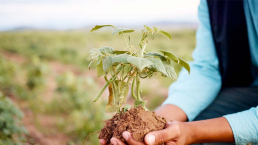
The Sahara Desert, the largest desert in the world, spans about 9.4 million square kilometers (3.6 million square miles) comparable in size to the territories of the United States or China. As the largest desert on Earth, the southward expansion of the Sahara Desert is considered one of the most severe issues related to global desertification. A research team from the University of Maryland announced that “since 1923, the Sahara Desert has expanded by more than 10% over approximately 100 years.” The United Nations Environment Programme also reported that less than 1% of Algeria’s land, adjacent to the Sahara, remains forested, while Ethiopia, once 50% forested, now has only 2.5% of its forest cover remaining.
Currently, approximately 2 billion people live in arid regions threatened by desertification. According to a World Economic Forum 2024 report, around 40 million people in Africa are already living under severe drought conditions. In response, the UNCCD launched the Great Green Wall Project, aiming to restore 386,000 square miles (100 million hectares) across 20 African countries by 2030. The Great Green Wall is a project primarily focused on addressing desertification, drought, and land degradation across Africa. This initiative involves 22 countries, stretching from Senegal in the west to Djibouti in the east, with the goal of planting vegetation over a distance of more than 8,000 kilometers (4,971 miles) to create a massive wall of trees.

Background of the Great Green Wall Initiative
The Great Green Wall initiative was launched in 2007 under the leadership of the African Union as a response to the environmental challenges facing the Sahel region. The Sahel is a semi-arid zone stretching across the African continent from the Atlantic Ocean in the west to the Red Sea in the east. Over 100 million people live in this region, with most relying on agriculture and livestock farming for their livelihoods. The Sahel faces severe environmental issues such as desertification, drought, and land degradation, exacerbated by climate change, overgrazing, deforestation, and poor land management practices. These challenges have led to increased food insecurity, poverty, and significant migration as people seek better livelihoods and living conditions.
The initiative aims to improve the living environment and livelihoods of people in the Sahel by planting trees, expanding vegetation areas, restoring degraded land, and preventing soil erosion.
Goal of the Great Green Wall Initiative
The Great Green Wall initiative, a flagship program of the African Union, aims to create a green belt across the entire Sahel region. The initiative supports the planting of a wide variety of trees and vegetation, including fruit trees, medicinal plants, and agroforestry crops, to restore degraded land and improve the livelihoods of local communities. By 2030, this initiative plans to plant over 100 million hectares of trees and vegetation, with the cooperation of national governments, local communities, civil society organizations, and international institutions. It is expected to sequester more than 250 million tons of carbon dioxide from the atmosphere. In addition to restoring the continent’s grasslands, the Great Green Wall Project aims to create 10 million green jobs by 2030.

Effect of the Great Green Wall Initiative
The Great Green Wall initiative is having a significant positive impact on both the environment and local communities.
Many of the social and economic challenges in the Sahel region are linked to the process of desertification. By planting trees and vegetation, the initiative restores degraded land, prevents soil erosion, and enhances soil fertility, which in turn boosts agricultural productivity and ensures a stable food supply. Since it is a reforestation project, it also helps reduce carbon dioxide in the atmosphere, contributing to the reduction of greenhouse gas emissions and aiding efforts to combat climate change.
In fact, across the countries participating in the Great Green Wall Project, nearly 18 million hectares of degraded land have been restored, and 350,000 jobs have been created, reflecting significant progress. The economic revitalization is seen as a potential solution to overcoming extremism and terrorism, which have been exacerbated by land degradation in the Sahel region.
Furthermore, the process of managing and cultivating forests has been shown to promote gender equality and improve local livelihoods. The Great Green Wall Project also symbolizes African unity and cooperation, as various nations and tribes form a network and work together, promoting regional integration.

Supplement
While the Great Green Wall initiative has many benefits, it also faces certain limitations. By 2020, the progress of the Great Green Wall Project had reached only 4% of its target. This slow progress is due to several factors, primarily a lack of funding, poor management and oversight, and inadequately allocated technical support.
Though limited, the successful stories of the Great Green Wall show that the initiative has the potential to bring tremendous economic, social, and environmental benefits to the Sahel and beyond.
Sustained commitment, strong partnerships, innovative approaches to funding, and implementation strategies are crucial for overcoming the current challenges. To address these issues, the UNCCD has launched the Great Green Wall Accelerator, aimed at speeding up the successful achievement of the initiative’s goals.









